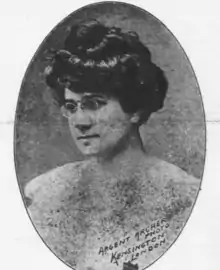Emma Azalia Hackley
Emma Azalia Hackley (1867–1922) was an African-American singer and political activist. She promoted racial pride through her support and promotion of music education for African Americans.
Emma Azalia Hackley | |
|---|---|
 | |
| Born | June 29, 1867 Murfreesboro, Tennessee, U.S. |
| Died | 1922 (aged 54–55)[1] Detroit, Michigan, U.S. |
| Spouse(s) | Edwin Henry Hackley (divorced) |
Born Emma Azalia Smith in Murfreesboro, Tennessee, she learned to play the piano at age three and took voice and violin lessons as a child. Due to her very light skin color and light hair, many people suggested that she try to pass for white in order to further her musical career. She refused to deny her heritage and remained intensely proud of her roots throughout her life. She moved with her parents to Detroit, Michigan where she graduated from high school in 1886.[2] After high school, she worked as an elementary school teacher before meeting and marrying Edwin Henry Hackley, an attorney and newspaper publisher from Denver, Colorado.
During her time in Denver she founded the Colored Women's League and co-founded the Imperial Order of Libyans with her husband. She received her bachelor's degree from the Denver School of Music in 1900. Emma Hackley promoted racial pride through music.[3]
In 1905, Hackley separated from her husband and moved to Philadelphia, Pennsylvania where she was the music director for the Episcopal Church of the Crucifixion.
Later in life, she trained artists such as Marian Anderson, Roland Hayes, and R. Nathaniel Dett. In 1911, she formed the Vocal Normal Institute in Chicago, Illinois.
In 1916, Hackley published The Colored Girl Beautiful,[4] a "how to" on becoming a refined African American lady.[5]
She died in Detroit, Michigan in 1922.[6]
A special collection, the E. Azalia Hackley Collection of African Americans in the Performing Arts, was founded in her name at the Detroit Public Library in 1943.
In popular culture

A portrait of Hackley, painted by Detroit artist Telitha Cumi Bowens, was included in the 1988/89 exhibit Ain't I A Woman at the Museum of African American History, Detroit. The exhibit featured a dozen prominent Black women from the state of Michigan, including the Honorable Cora M. Brown, Ethelene Jones Crockett, M.D., and teacher Fannie M. Richards.[7]
References
- Taylor, Julius F. "The Broad Ax" (December 30, 1922). Retrieved 22 June 2015.
- Peterson, Heather. "Emma Azalia Hackley". Retrieved 18 February 2016.
- Peterson, Heather. "Hackley, Emma Azalia". The Black Past. Retrieved 19 February 2016.
- "The Colored Girl Beautiful by E. Azalia Hackley - Free Ebook". 2019-05-24. Archived from the original on 2019-05-24. Retrieved 2019-05-24.
- Hackley, E. Azalia (Emma Azalia) (21 February 2010). "The Colored Girl Beautiful". Retrieved 1 January 2019.
- Bowen, Susan W. "African-American Woman Was A Pioneer In The American Classical Music Tradition". Schiller Institute. Retrieved 22 June 2015.
- Ain't I A Woman, an exhibition catalogue. Detroit, MI: Museum of African American History. 1989. pp. 19–21.
External links
- Emma Azalia Hackley at Find a Grave
- Photographs of Emma Azalia Hackley from the E. Azalia Hackley Collection of African Americans in the Performing Arts at the Detroit Public Library.
| Wikimedia Commons has media related to Emma Azalia Hackley. |